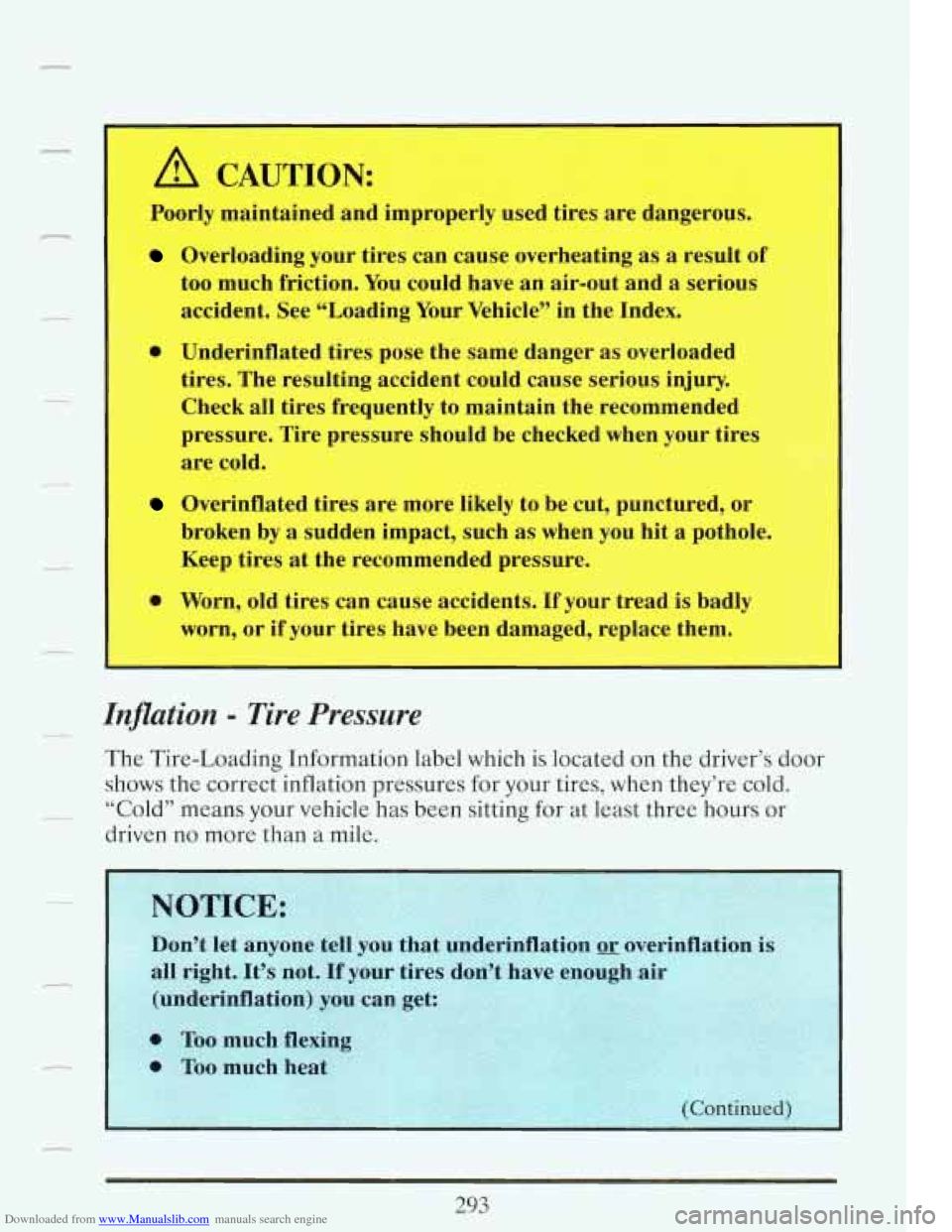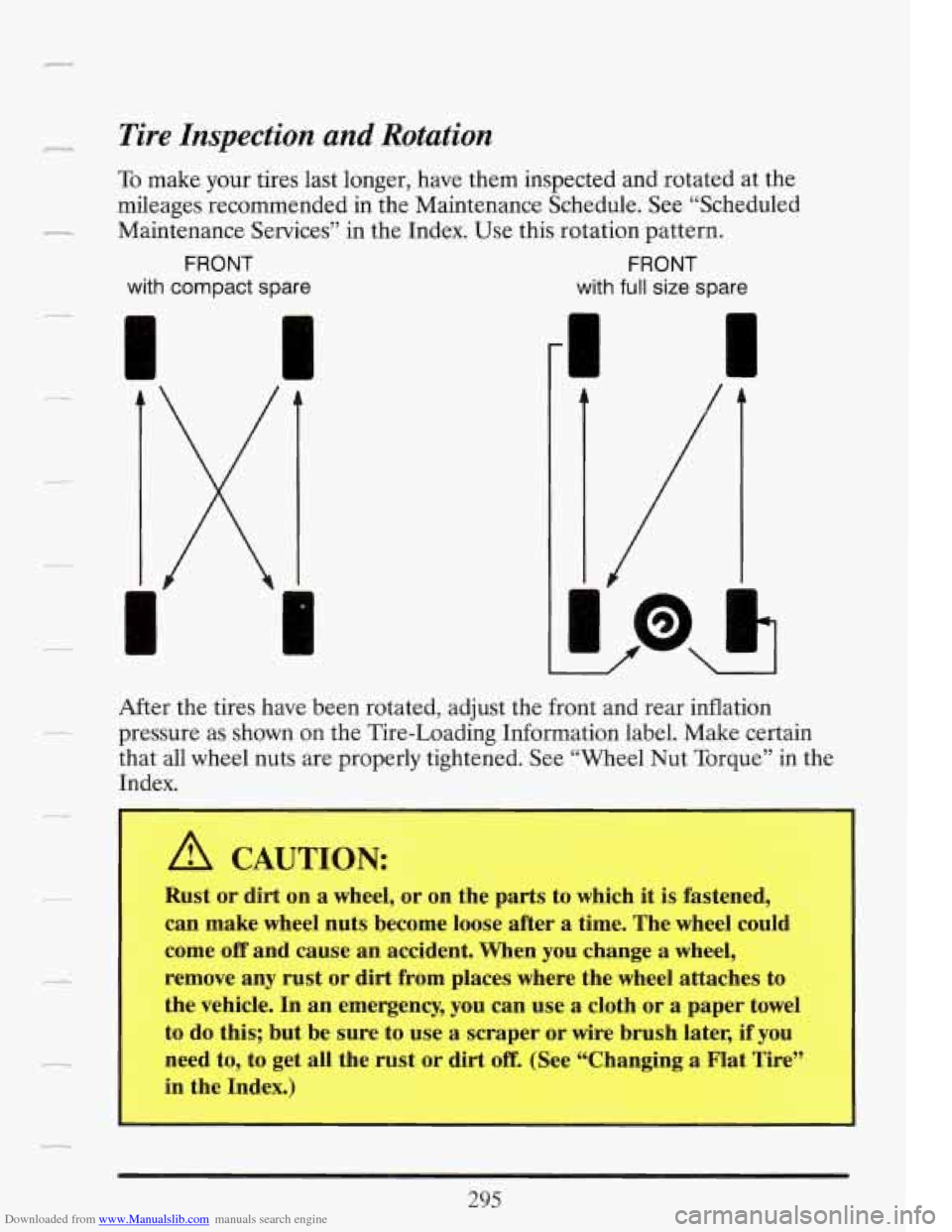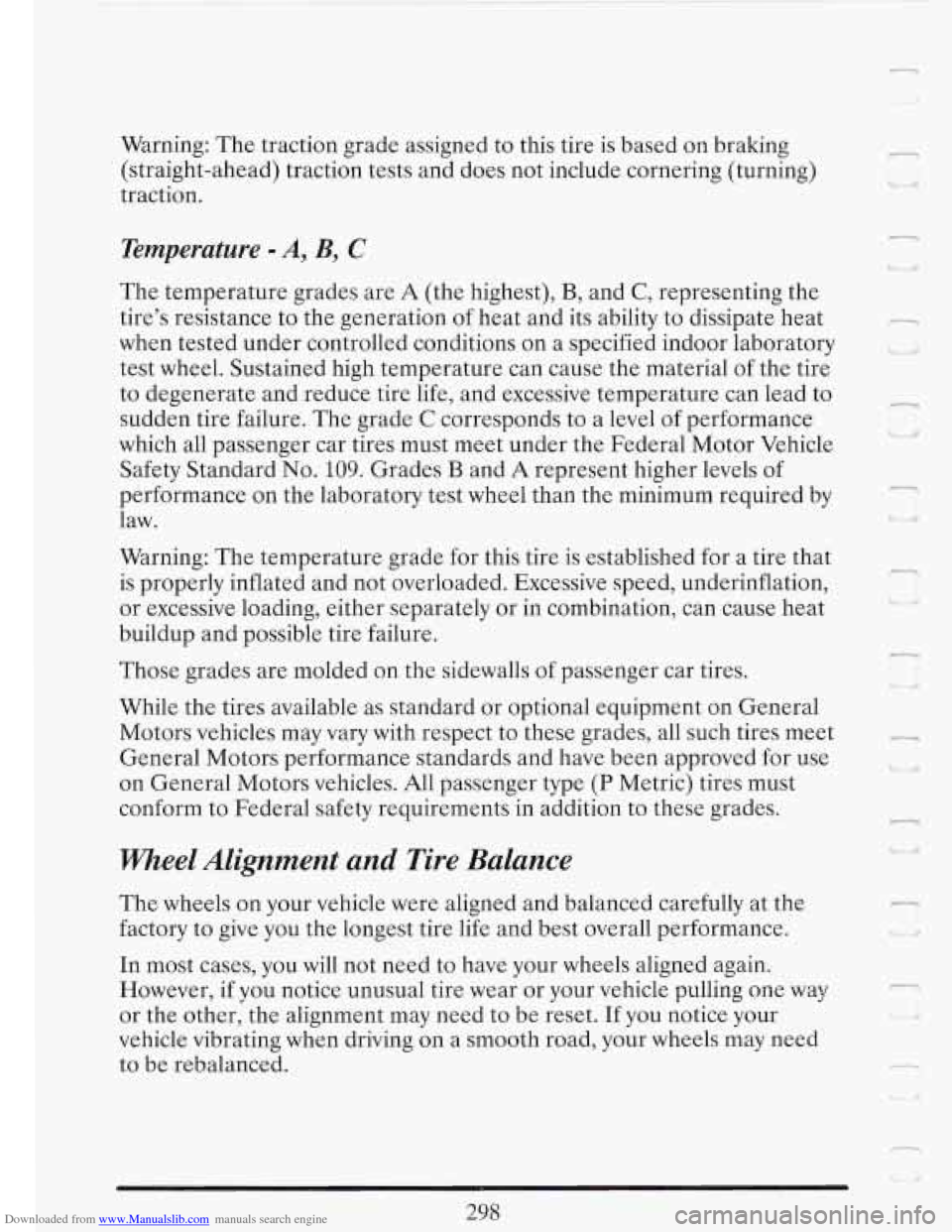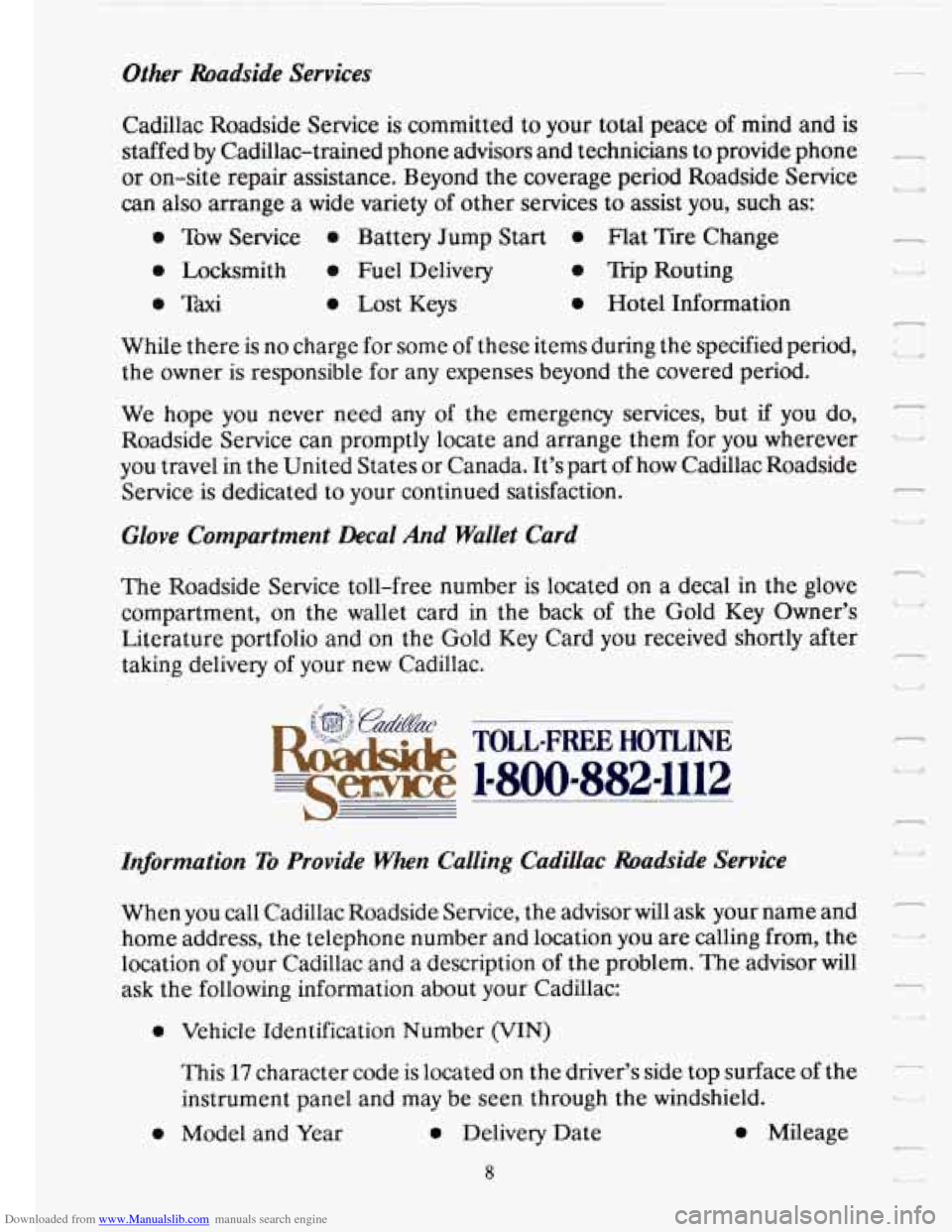Page 262 of 386
Downloaded from www.Manualslib.com manuals search engine Align the upper
locator pins and insert
-
the pins into the holes. .
n
Push the handles up to lock the skirt in place.
COMPACT SPARE TIRE
Although the compact spare was fully inflated when your vehicle was
new, it can lose air after a time. Check the inflation pressure regularly. It
should be
60 psi (420 kPa). The compact spare is made to go up to 3,000 -
miles (5000 km), so you can finish your trip and have your full-size tire i* u
repaired or replaced where you want. Of course, it’s best to replace your I
spare with a full-size tire as soon as you can. Your spare will last longer
and be in good shape in case you need it again.
Your anti-lock brake system warning light may come on when
you are
driving with a compact spare. See “Anti-Lock Brake System Warning
Light” in the Index.
Don’t use your compact spare on some other vehicle.
248
Page 304 of 386
Downloaded from www.Manualslib.com manuals search engine I
3. Reinstall the new
insert by aligning
the blade housing
tabs and the edge
of the insert. Make
sure that the insert
is connected to all
the housing tabs.
4. Install the wiper blade assembly to the wiper arm.
LOmING YOUR VEHICLE
OCCUPANTS VEHICLE CAP.
WT.
TIRE-LOADING INFORMATION
FRT. CTR.
RR. TOTAL LBS. KG
MAX. LOADING & GVWR SAME AS VEHICLE
CAPACITY WEIGHT XXX COLD TIRE
TIRE
SIZE SPEED PRESSURE RTG
PSVKPa
FRT.
R R.
SPA.
IF TIRES ARE HOT. ADD 4PSV28KPa SEE
OWNER’S MANUAL FOR ADDITIONAL
INFORMATION
GEN GME
Two labels on your vehicle show how much weight it may properly carry.
The Tire-Loading Information label found on the driver’s door tells you
the proper size, speed rating and recommended inflation pressures for
n
290
Page 307 of 386

Downloaded from www.Manualslib.com manuals search engine A CAUTION:
i --
Poorly maintained and improperly used tires are dangerous.
Overloading your tires can cause overheating as a result of
I
too much friction. You could have an air-out and a serious
accident. See “”Loading Your Vehicle” in the Index.
0 Underinflated tires pose the same danger as overloaded
tires. The resulting accident could cause serious injury.
Check all tires frequently
to maintain the recommended
pressure. Tire pressure should
be checked when your tires
are cold.
I
I Overinflated tires are more likely to be cut, punctured, or
broken by
a sudden impact, such as when you hit a pothole.
Keep tires at the recornmended pressure.
@ Worn, old tires can cause accidents. If your tread is badly
worn, or if your tires have been damaged, replace them.
Inflation - Tire Pressure _c
The Tire-Loading Information label which is located on the driver’s door
shows the correct inflation pressures
for your tires, when they’re cold.
driven no more than a mile.
- “Cold’’ means your vehicle has been sitting for at least three hours or
293
Page 308 of 386
Downloaded from www.Manualslib.com manuals search engine ea
When to Check Check your tires once a month or more.
Don't forget your compact spare tire. It should be at
60 psi (420 kPa).
How to Check Use a good quality pocket-type gage to check tire
pressure. Simply looking at the tires
will not tell you the pressure,
especially
if you have radial tires -- which may look properly inflated even
if they're underinflated.
If your tires have valve caps, be sure to put them back on. They help
prevent leaks by keeping out dirt and moisture.
Your tire pressures are:
Front and rear - 30 psi (210 kPa)
Optional Limousine packages:
Front and rear - 35 psi (241 kPa)
Recommended tire size is:
0 P235/70R15 (Front and rear)
0 T145/80D 16 (Compact spare)
0 P235/75R15 XL (Coach Builder Option) d
n
'd I
294
Page 309 of 386

Downloaded from www.Manualslib.com manuals search engine P Tire Inspection and Rotation
To make your tires last longer, have them inspected and rotated at the
mileages recommended in the Maintenance Schedule. See “Scheduled
- Maintenance Services” in the Index. Use this rotation pattern.
FRONT FRONT
with compact spare
with full size spare
cs
r
A
I
After the tires have been rotated, adjust the front and rear inflation
pressure as shown on the Tire-Loading Information label. Make certain
that all wheel nuts are properly tightened. See “Wheel Nut Torque” in the
Index.
A CAUTION:
Rust or dirt on a wheel, or on the parts to which it is fastened,
can make wheel nuts become loose after a time. The wheel could
come
off and cause an accident. When you change a wheel,
remove any rust
or dirt from places where the wheel attaches to
the vehicle. In an emergency, you can use
a cloth or a paper towel
to do this; but be sure to use a scraper
or wire brush later, if you
need to, to get all the rust
or dirt off. (See “Changing a Flat Tire”
in the Index.)
295
Page 312 of 386

Downloaded from www.Manualslib.com manuals search engine 7
. .J
Warning: The traction grade assigned to this tire is based on braking
(straight-ahead) traction tests and does not include cornering (turning)
traction.
Temperature - A, B, C
The temperature grades are A (the highest), B, and C, representing the
tire's resistance to the generation of heat and its ability to dissipate heat
when tested under controlled conditions on a specified indoor laboratory
test wheel. Sustained high temperature can cause the material of the tire
to degenerate and reduce tire life, and excessive temperature can lead to
sudden tire failure. The grade
C corresponds to a level of performance
which all passenger car tires must meet under the Federal Motor Vehicle
Safety Standard
No. 109. Grades B and A represent higher levels of
performance on the laboratory test wheel than the minimum required by
law.
Warning: The temperature grade
for this tire is established for a tire that
is properly inflated and not overloaded. Excessive speed, underinflation,
or excessive loading, either separately or
in combination, can cause heat
buildup and possible tire failure.
Those grades are molded on the sidewalls of passenger car tires.
While the tires available as standard or optional equipment on General
Motors vehicles may vary with respect to these grades, all such tires meet
General Motors performance standards and have been approved for use
on General Motors vehicles.
All passenger type (P Metric) tires must
conform to Federal safety requirements in addition to these grades.
'Wheel Alignment and Tire Balance
The wheels on your vehicle were aligned and balanced carefully at the
factory to give you the longest tire life and best overall performance.
In most cases, you will not need
to have your wheels aligned again.
However,
if you notice unusual tire wear or your vehicle pulling one way
or the other, the alignment may need to be reset.
If you notice your
vehicle vibrating when driving
on a smooth road, your wheels may need
to be rebalanced.
3
I
c
UI
n
9
u
298
Page 348 of 386

Downloaded from www.Manualslib.com manuals search engine Additional No Charge Roadside Service Special Features For Cadillac ~ ~-
Owners:
0 Emergency Road Service Performed at the Scene for the Following -
Disablements - during the first 12 month/12,000 mile period.
a Lock Out Assistance Battery Jump Starts
a Gas Delivery 0 Flat Tire Change
0 Towing Service (Covers Change Only')
*Determination
of replacement tire under Warranty Coverage must
be made
by a Cadillac dealership or appropriate tire manufacturer.
n
m :i
U
r
r
U
nip Interruption - If your trip is interrupted due to a warranty failure,
incidental expenses may be reimbursed during
the 12 months/12,000 -
mile period. Items covered are hotel, meals and rental car.
0 nip Routing - Free trip routing assistance is available during the first
four years.
Within a week of contacting Roadside Service wlth your -
travel plans, Cadillac will provide a detailed trip rouling and
personalized North American Road Altas.
How Do You Pay For Roadside Service?
Payment is due at the time the repair is performed. Payment maybe made by __
cash, personal check or any major credit card honored by the participating
Cadillac dealership.
6
i
c
Page 350 of 386

Downloaded from www.Manualslib.com manuals search engine Other Roadside Services
Cadillac Roadside Service is committed to your total peace of mind and is
staffed by Cadillac-trained phone advisors and technicians to provide phone
or on-site repair assistance. Beyond the coverage period Roadside Service
can also arrange a wide variety of other services to assist you, such as:
0 Tow Service 0 Battery Jump Start 0 Flat Tire Change
0 Locksmith 0 Fuel Delivery 0 Trip Routing
0 Tmxi 0 Lost Keys 0 Hotel Information
While there is no charge for some
of these items during the specified period,
the owner is responsible for any expenses beyond the covered period.
We hope you never need any of the emergency services,
but if you do,
Roadside Service can promptly locate and arrange them
for you wherever
you travel in the United States or Canada. It’s part
of how Cadillac Roadside
Service is dedicated to your continued satisfaction.
Glove Compartment Decal And Wallet Card
The Roadside Service toll-free number is located on a decal in the glove
compartment, on the wallet card
in the back of the Gold Key Owner’s
Literature portfolio and
on the Gold Key Card you received shortly after
taking delivery of your new Cadillac.
Information To Provide When Calling Cadillac Roadside Service
When you call Cadillac Roadside Service, the advisor will ask your name and
home address, the telephone number and location you are calling from, the
location of your Cadillac and a description of the problem. The advisor will
ask the following information about your Cadillac:
0
0
Vehicle Identification Number (VIN)
ui
This 17 character code is located on the driver’s side top surface of the -
instrument panel and may be seen through the windshield.
Model and Year
0 Delivery Date 0 Mileage -
8